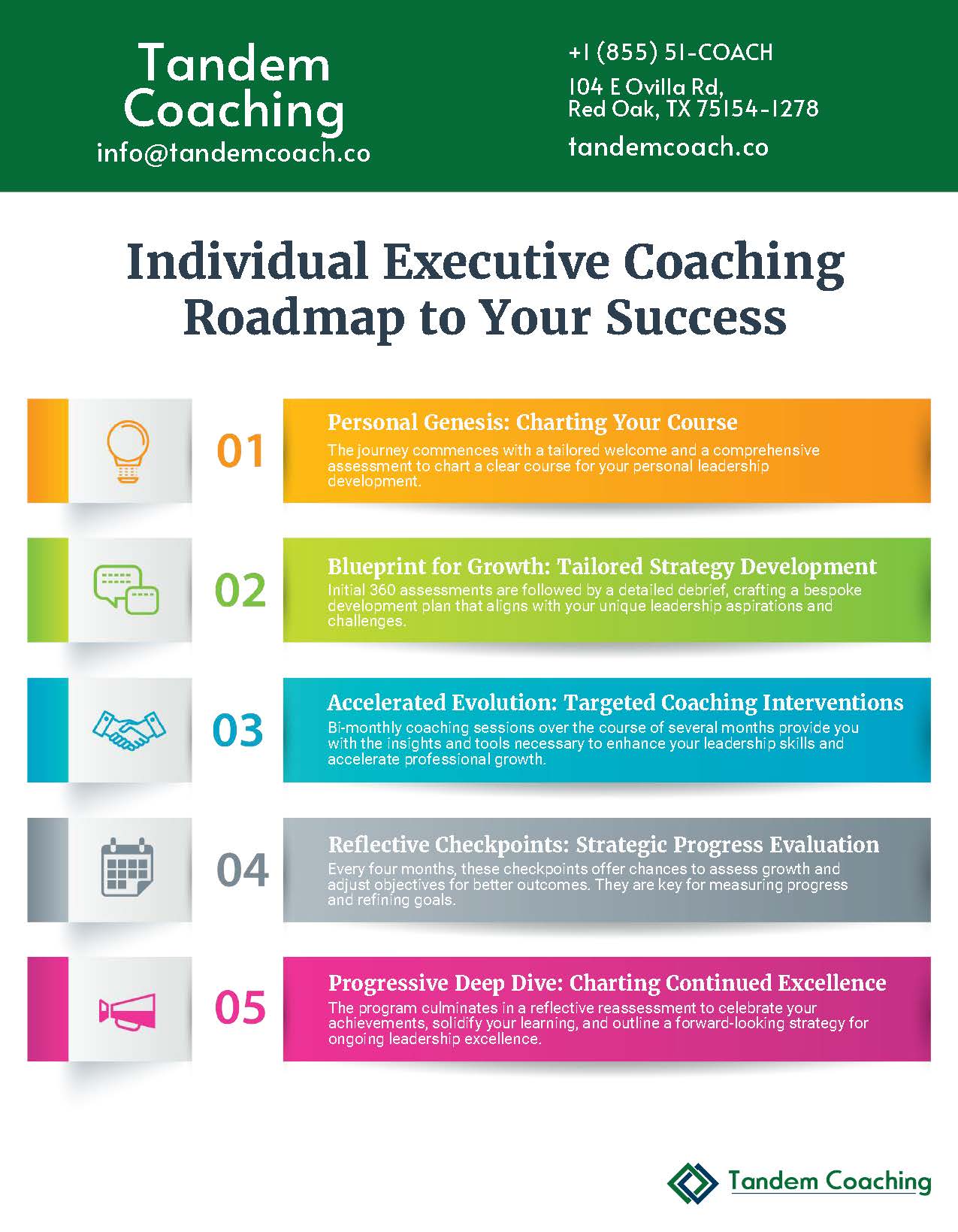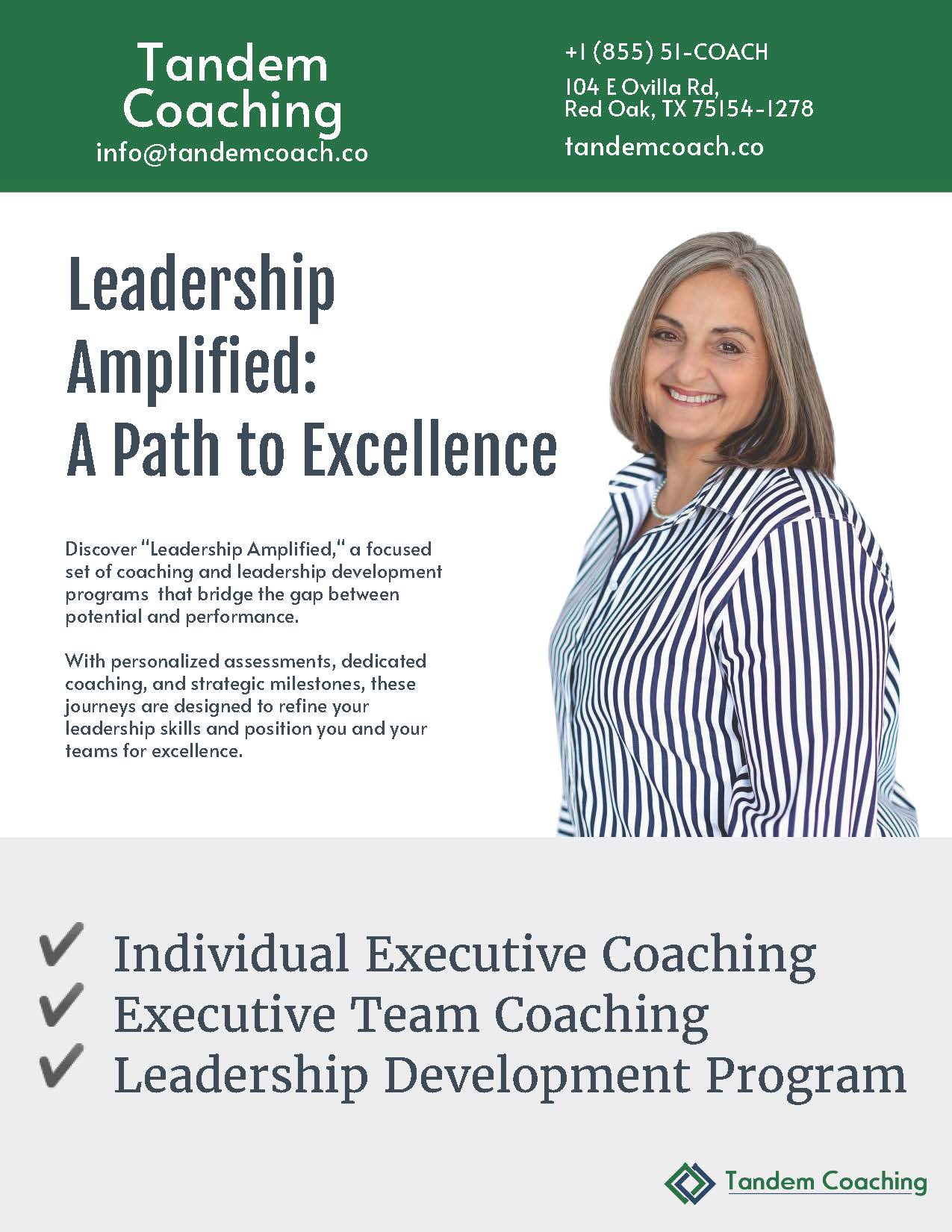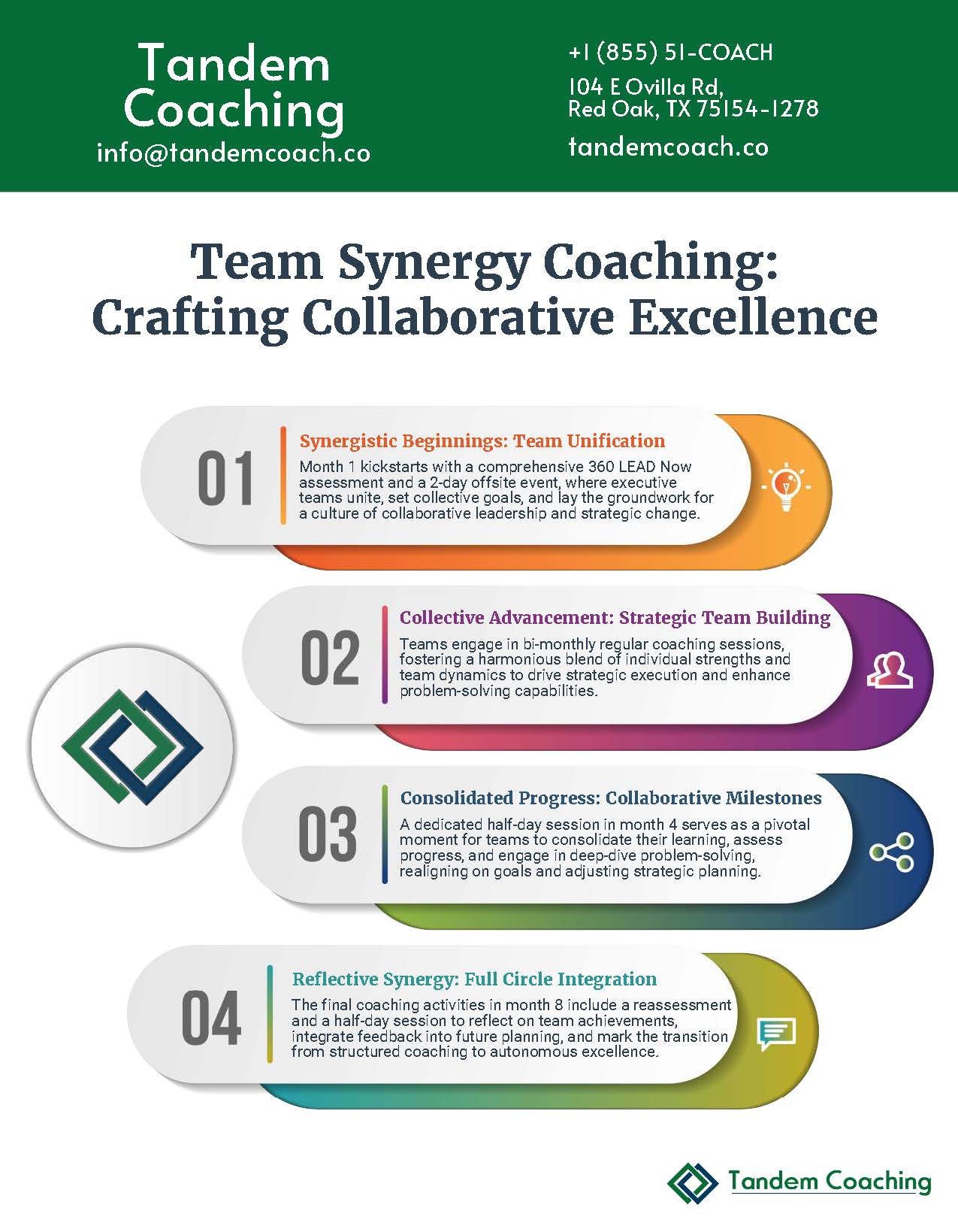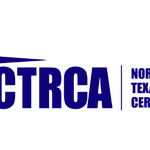Jennifer pulled up her calendar during our session last week. “Look at Tuesday,” she said. “This is why I can’t get anything done.”
9:00 AM: Strategic planning. 9:30 AM: Quick sync with CFO about projections. 9:45 AM: Emergency customer call. 10:00 AM: Board member check-in. 10:30 AM: Back to strategic planning. 11:00 AM: Performance review.
“By the time I got back to strategic planning at 10:30,” she told me, “I couldn’t remember what I was trying to solve at 9:00. I had to start over.”
Here’s what Jennifer had already done right: she’d consolidated her tool stack after our productivity audit. Down from seventeen tools to five. Beautiful integration. But she was still losing massive productivity because tool switching and context switching are completely different problems. You can have perfect tools and still tank your productivity by jumping between strategic thinking, financial analysis, crisis management, and people decisions every thirty minutes.
We decided to calculate the actual cost together. That Tuesday morning alone—roughly $12,000 in lost strategic value. Jennifer did the multiplication herself and just stared at the number. When we looked at the research on executive context switching—40% productivity loss for those switching every 11 minutes—she calculated her annual impact: $3 million.
“But I don’t have a choice,” she said. “These are all important.”
She’s right. And that’s exactly why we need a different solution.
The $3 Million Executive Context Switching Crisis
Let me share something that changed how I think about executive attention: Harvard Business Review found that knowledge workers toggle between applications and websites nearly 1,200 times per day. But here’s what they didn’t measure—executives aren’t just switching apps. We’re switching entire mental frameworks.
Think about your last hour. How many times did you shift from team focus to organizational focus? From operational details to strategic vision? From this quarter’s numbers to next year’s roadmap? Each shift isn’t just a toggle—it’s a complete reconstruction of context, assumptions, priorities, and decision criteria.
The research gets worse. Gloria Mark’s research at UC Irvine shows it takes an average of 23 minutes and 15 seconds to fully refocus after an interruption. But that’s for simple task switching. When you’re switching between complex executive contexts—say, from evaluating M&A opportunities to handling a customer crisis—the recovery time extends even further.
I worked with Marcus, a VP of Product at a fintech startup, who tracked his context switches for one week. The results? Fifty-three major context switches per day. Not task switches—full context reconstructions. Using the 23-minute recovery metric, he was spending over 20 hours per day just recovering from switches. Obviously impossible, which means he never fully recovered. He operated in a permanent state of partial attention.
This isn’t about being unfocused or lacking discipline. It’s about the fundamental mismatch between how our brains process information and what modern executive roles demand. Your brain treats each context switch like shutting down one operating system and booting up another. The cognitive overhead is enormous.
“Every context switch carries a tax that compounds throughout the day. By 3 PM, most executives are operating at 40% cognitive capacity, not from fatigue but from context residue.”
What’s particularly insidious is that context switching creates a cascading effect throughout your organization. When you switch contexts constantly, you create switches for everyone around you. Your scattered attention fragments your team’s focus. One executive’s context chaos can trigger dozens of switches across the organization.
The Five Executive Context Layers
There are five distinct cognitive frameworks that executives constantly navigate. Understanding these layers is crucial because each requires different mental models, decision criteria, and emotional states.
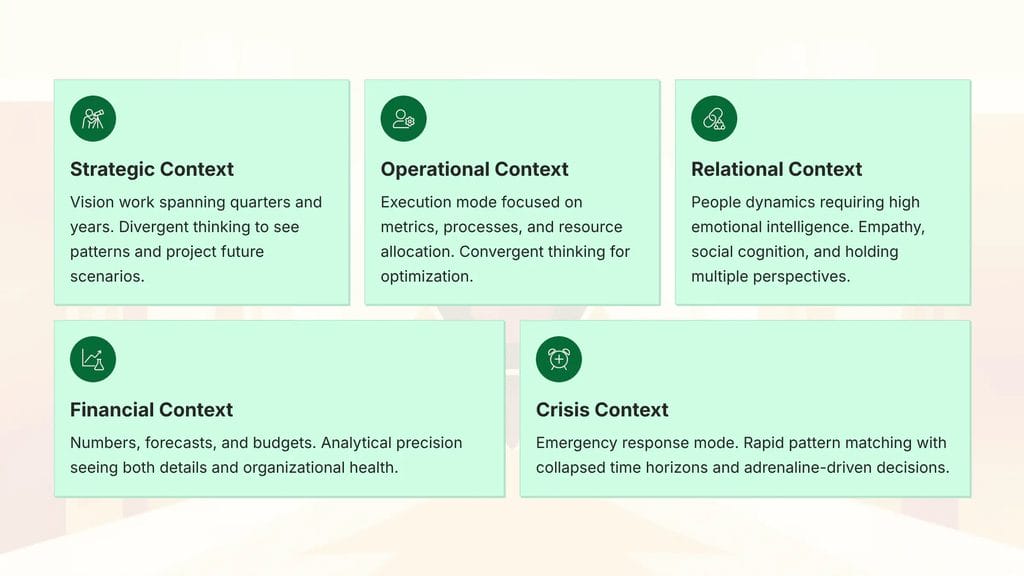
Strategic Context is where you’re thinking quarters and years ahead. This is vision work, market positioning, competitive strategy. Your brain needs to hold complex, interconnected systems while projecting multiple future scenarios. It requires what researchers call “divergent thinking”—the ability to see patterns others miss.
Operational Context is execution mode. Metrics, processes, sprint planning, resource allocation. Your brain shifts to convergent thinking—taking broad possibilities and narrowing them to specific actions. The mental model here is about optimization and efficiency, completely different from strategic work.
Relational Context involves people dynamics. One-on-ones, team culture, stakeholder management, board relationships. This requires high emotional intelligence and the ability to hold multiple perspectives simultaneously. Your brain activates entirely different regions—the ones involved in empathy, social cognition, and emotional regulation.
Financial Context is numbers, forecasts, budgets, burn rates. This analytical mode requires precision and the ability to see both forest and trees—understanding how individual line items roll up to organizational health. It’s neither purely strategic nor operational but requires elements of both.
Crisis Context is the emergency response mode. System outages, customer escalations, PR fires. Your brain floods with adrenaline, time horizons collapse to hours or minutes, and decision-making shifts to rapid pattern matching based on previous experiences.
Here’s why this matters: You can’t simply decide to “focus on strategy today.” Your role requires you to operate across all five contexts, often within the same hour. A board member calls about strategic direction (Strategic Context), followed by a customer crisis (Crisis Context), then a budget review (Financial Context), and a skip-level one-on-one (Relational Context).
Each transition carries what psychologists call “context residue”—fragments of the previous context that contaminate your thinking in the next one. That strategic concern bleeds into your performance review. The crisis adrenaline affects your budget decisions. The emotional weight of a difficult conversation clouds your strategic thinking.
Building Your Context Architecture
The solution isn’t to eliminate context switching—that’s impossible at executive level. Instead, we need to build an architecture that minimizes switching costs and maximizes recovery. This is what I call Context Architecture, and it has four core components.
Context Batching is the foundation. Instead of letting contexts intermingle throughout your day, you create dedicated blocks for similar cognitive work. Jennifer now batches all her strategic work into Tuesday and Thursday mornings. Monday afternoon is for operational reviews. Wednesday is her “people day”—all one-on-ones, team meetings, and culture work.
But here’s the key insight: batching only works if you protect the boundaries ruthlessly. Jennifer’s assistant now knows that unless the building is literally on fire, nothing interrupts strategic blocks. They’ve created a decision tree for what constitutes a true emergency versus what can wait three hours.
The Interrupt Protocol is your systematic response to the inevitable disruptions. Because let’s be real—you will get interrupted. The key is having a protocol that minimizes the damage. When Jennifer gets pulled into something urgent during a strategic block, she follows a three-step protocol: First, she writes one sentence about what she was thinking. Second, she sets a timer for the interruption—maximum 15 minutes. Third, she does a 60-second transition ritual when returning (deep breathing, reviewing her note, physically changing position).
This might sound simple, but it’s based on cognitive science. That one sentence serves as what researchers call an “encoding cue”—it helps your brain reconstruct the context faster. The timer prevents scope creep. The transition ritual signals to your brain that you’re switching contexts intentionally, not reactively.
Context Moats are the protective barriers around your deep work. These aren’t just “do not disturb” settings—they’re comprehensive protection systems. Jennifer’s context moats include: automated Slack status changes based on calendar blocks, different phone numbers for different contexts (strategic planning goes to voicemail), and even different physical spaces when possible (strategic work happens in a conference room, not her office where people drop by).
I’ve seen executives get creative with context moats. One CEO wears different colored lanyards to signal which context he’s in. His team knows that a red lanyard means crisis mode only—don’t approach unless something’s actually on fire. Blue means strategic thinking—he’s completely unavailable. Green means operational—normal interruptions are okay.
The Context Cache is your method for saving state when switching is unavoidable. Just like computer processors cache data when switching between programs, you need a system for preserving context when you must switch. Jennifer now has a simple template on her desk:
- What was I solving?
- What’s the next specific action?
- What decision was I approaching?
- What context do I need to remember?
Filling this out takes 30 seconds but saves 20 minutes of reconstruction time. It’s the executive equivalent of leaving breadcrumbs to find your way back.
Carnegie Mellon’s research shows that when developers work on five projects simultaneously, they’re only 20% productive on actual work, with 80% lost to context switching. The same principle applies to executive work, but the contexts are even more complex than code.
Team Training for Context Protection
Your personal context architecture only works if your team understands and supports it. This isn’t about being unavailable—it’s about being strategically available. The paradox is that protecting your context makes you more valuable to your team, not less.
I introduce teams to the concept of “context cost awareness.” Before interrupting an executive, team members ask themselves: What context is she likely in? What’s the switching cost? Can this wait for the appropriate context window? It’s not about creating barriers—it’s about creating consciousness.
Jennifer’s team now uses what we call the “Interrupt Budget.” Each team member gets a certain number of context-breaking interruptions per week. Use them wisely. This gamification makes people think twice before that “quick question” that derails strategic thinking. Interestingly, once we implemented this, actual emergencies were handled faster because the noise decreased.
The Escalation Matrix is another critical tool. We mapped out exactly which situations warrant immediate escalation versus what can wait for the next context window. Customer down? Immediate. Contract question? Wait for operational block. Team conflict? Wait for people day. This clarity eliminated 70% of Jennifer’s interruptions.
But here’s what really transformed things: we trained the team on their own context switching. Once they understood how it affected their productivity, they became allies in protecting everyone’s context. They started batching their questions, saving non-urgent items for scheduled check-ins, and respecting each other’s deep work blocks.
We also implemented “Context Bridges”—team members who can handle certain decisions without escalation. If Jennifer is in strategic planning mode and an operational decision needs to be made, her operations lead has full authority to decide. This requires trust and clear boundaries, but it’s transformative.
“Teaching your team about context switching isn’t just about protecting your time—it’s about multiplying the entire organization’s cognitive capacity.”
Recovery Protocols: When Context Switching Is Unavoidable
Sometimes you have no choice. The board member calls during your strategic planning block. A crisis erupts during your one-on-one. A customer escalation interrupts everything. What then?
First, accept the cost. Fighting the interruption creates additional cognitive load. Jennifer learned to say, “Okay, I’m switching contexts. This will cost me 20 minutes of recovery. It’s worth it for this issue.” This acceptance, paradoxically, reduces the actual switching cost.
The Rapid Reset Protocol helps minimize damage. After an unavoidable context switch, take 90 seconds to: Close your eyes and take five deep breaths. Physically move—stand, stretch, walk to the window. Review your context cache note. Set a timer for five minutes to ease back into the original work. This might seem like you’re losing more time, but research shows this investment reduces recovery time by 40%.
Daily Context Reset Rituals prevent accumulation of context residue. Jennifer ends each day with a 10-minute ritual: reviewing which contexts she operated in, noting any unfinished thoughts, and preparing tomorrow’s context cache cards. This prevents context residue from contaminating the next day’s thinking.
Weekly Architecture Reviews keep your system adaptive. Every Friday, Jennifer reviews her context switching patterns. Which batches held? Where did the system break? What patterns emerged? This isn’t about perfection—it’s about continuous refinement.
I also recommend what I call “Context Detox” periods. Once a week, spend two hours in a single context with absolutely no switches. No email checks, no quick questions, no “while I have you” conversations. This reminds your brain what deep, sustained focus feels like and rebuilds your capacity for single-context work.
The compound effect is remarkable. Jennifer’s team reported that within six weeks of implementing these protocols, their own productivity increased by 30%. Not because Jennifer was doing more, but because her protected context time meant clearer decisions, better strategic direction, and fewer false starts.
Frequently Asked Questions
How is this different from time blocking or calendar management?
Time blocking manages when you work. Context architecture manages how your brain works. You can have perfect time blocks but still destroy productivity by mixing contexts within those blocks. I’ve seen executives with beautiful calendars who still operate at 40% capacity because they’re answering strategic questions during operational blocks, handling crises during planning time, and thinking about performance reviews during board prep. Context architecture ensures that your brain is in the right mode for the work at hand.
What if my role requires instant availability? I can't have two-hour blocks of protected time.
Start smaller. Even 30-minute protected contexts make a difference. One emergency room director I worked with could only protect 25-minute blocks, but those focused intervals transformed his strategic thinking. Also, examine “instant availability” closely. Often, it’s organizational habit, not actual requirement. We usually find that 80% of “urgent” requests can wait 30-60 minutes with proper escalation protocols.
How do I handle board members or C-suite peers who expect immediate responses?
Education and demonstration. Share the context switching research. More importantly, show results. When Jennifer’s strategic initiatives started moving faster because of protected context time, her board became advocates for her context architecture. One board member now schedules his calls specifically during her strategic blocks because he knows she’ll be in the right mental space for those discussions.
Won't batching contexts make some things wait too long?
Initially, yes. Some things will wait an extra day or two. But the increased quality and speed of decision-making more than compensates. Jennifer found that decisions she used to revisit three times because of poor initial thinking now stick the first time. The net result is faster progress despite individual items waiting longer.
How do I know which context I should be in at any given time?
Your cognitive contexts from your GTD system provide the foundation. But also consider your energy patterns. Most executives do strategic work best in the morning when cognitive resources are fresh. Relational work often fits better in afternoons when social energy peaks. Track your patterns for a week—you’ll quickly see when each context works best for your brain.
What about contexts that don't fit the five layers?
The five layers are frameworks, not rules. You might have a sixth context—perhaps “Creative” or “Learning.” The key is identifying your distinct cognitive modes and the switching costs between them. One executive identified “Board Context” as separate from Strategic because it required a different communication style and risk framework.
Can context switching ever be beneficial?
In short bursts, yes. Some research suggests brief context switches can prevent cognitive fatigue. The key word is “brief” and “intentional.” A five-minute walk between strategic planning sessions isn’t context switching—it’s cognitive restoration. The damage comes from uncontrolled, reactive switching between complex contexts.
How long does it take to see results from context architecture?
Individual benefits appear within days—you’ll feel the difference immediately when you complete a two-hour strategic block without interruption. Team-level benefits emerge within 2-3 weeks as everyone adapts. Organizational impact becomes measurable within 6-8 weeks. Jennifer saw a 40% increase in strategic initiative completion within two months.
Context switching isn’t just an executive inconvenience—it’s an organizational crisis that compounds throughout your company. Every fragmented hour of executive attention creates ripples of inefficiency, delayed decisions, and strategic drift.
But here’s the opportunity: solving your context switching problem creates competitive advantage. While your competitors lose 40% of their leadership capacity to context chaos, you operate with full cognitive power. Your strategic thinking goes deeper. Your decisions stick. Your team operates with clarity instead of confusion.
The first step is awareness. Track your context switches for just one day. Not task switches—full context transitions. Count every shift from strategic to operational, from analytical to relational, from crisis to planning. The number will shock you.
Then calculate your context tax. Take your hourly rate, multiply by 0.4 (the productivity loss from context switching), then multiply by your daily context switches. That’s your daily context tax. Jennifer’s was $4,800. Per day.
That’s why I’ve created the Context Cost Calculator—a tool that helps you quantify not just the time lost but the strategic value destroyed by context switching. It factors in your role level, industry, and specific context patterns to show the real dollar impact on your organization.
But the calculator is just the beginning. The real work is building your Context Architecture—the systematic approach to protecting and managing your cognitive resources. This integrates with your systematic transformation approach and prepares you for advanced techniques like the delegation framework that protects focus.
As you advance, you’ll also want to manage your cognitive load more effectively, implement advanced attention management techniques, and align with your energy patterns to maximize the impact of your protected context time.
The choice is yours. Continue losing $3 million annually to context chaos, or build an architecture that protects and multiplies your cognitive capacity. Jennifer chose to build. Six months later, her strategic initiatives are ahead of schedule, her team is more autonomous, and her board has noticed the dramatic improvement in strategic clarity.
More importantly, she’s rediscovered what deep thinking feels like. “I forgot I could think this clearly,” she told me last week. “It’s like someone cleaned my mental windshield.”
That clarity is waiting for you too. Download the Context Cost Calculator. Map your five contexts. Build your first context moat. Your brain—and your organization—will thank you.
Ready to stop the $3 million drain? Schedule a consultation to build your personalized Context Architecture. Because every minute you wait, context chaos is stealing your strategic advantage.
Struggling to protect your deep work from constant interruptions? Download the free Context Cost Calculator to quantify your context switching impact and build your protection strategy. Because executive attention isn’t just valuable—it’s irreplaceable.











